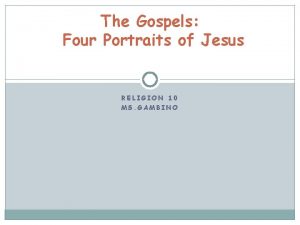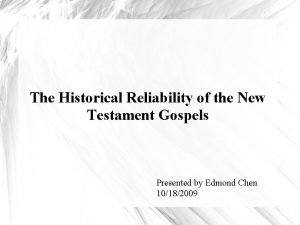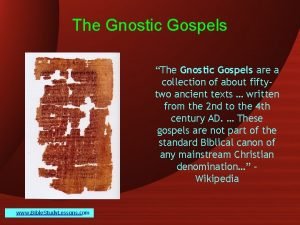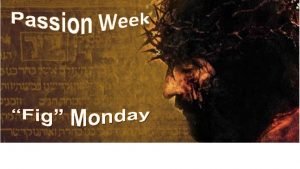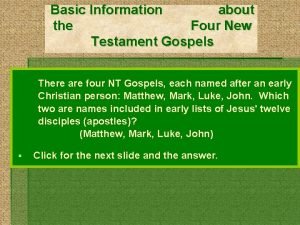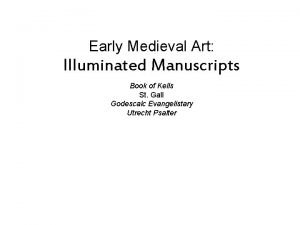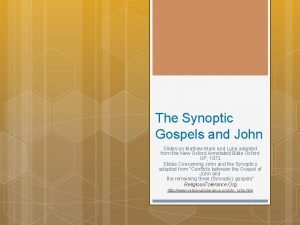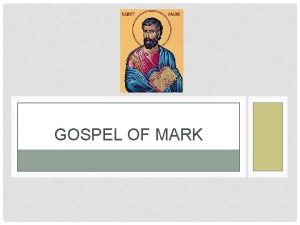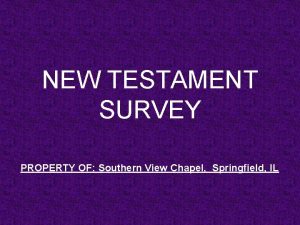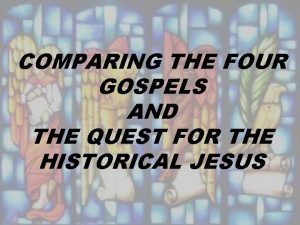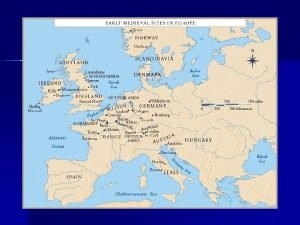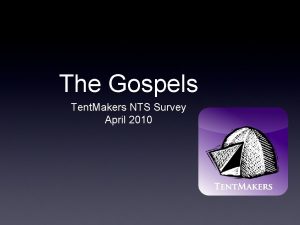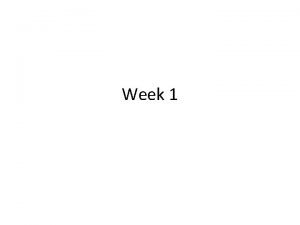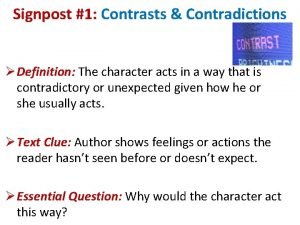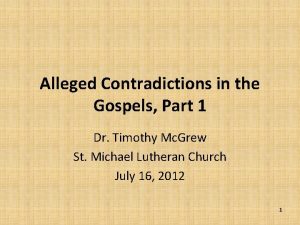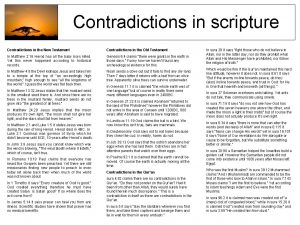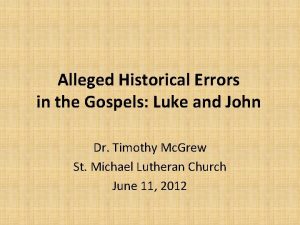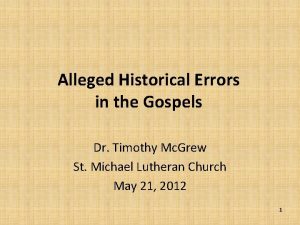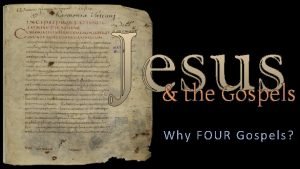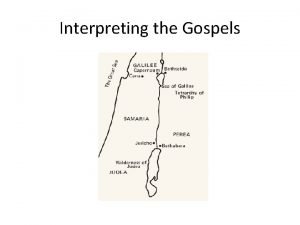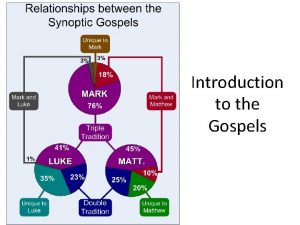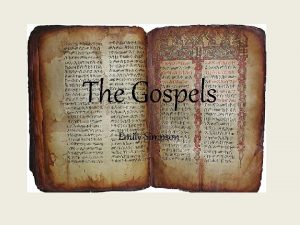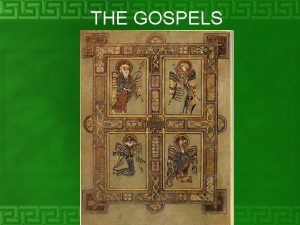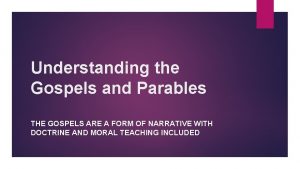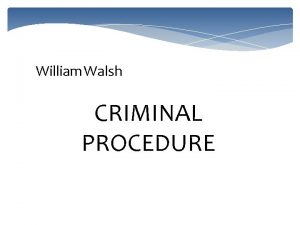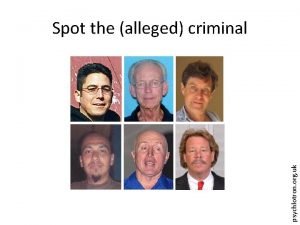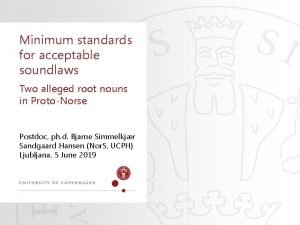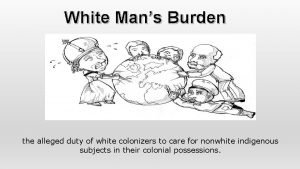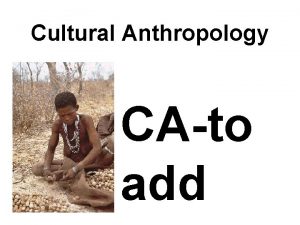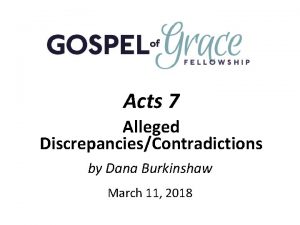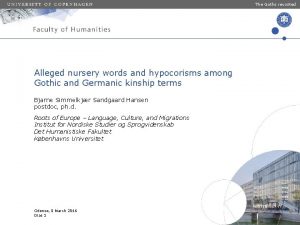Alleged Contradictions in the Gospels Part 2 Dr






![The charge: the Gospels are “hopelessly contradictory” • “[T]he sources [regarding Jesus’ resurrection] are The charge: the Gospels are “hopelessly contradictory” • “[T]he sources [regarding Jesus’ resurrection] are](https://slidetodoc.com/presentation_image_h2/ecf445b94acede759c73bbc8a1201fe4/image-7.jpg)
























































- Slides: 63

Alleged Contradictions in the Gospels, Part 2 Dr. Timothy Mc. Grew St. Michael Lutheran Church August 20, 2012 1

2 Peter 3: 16 There are some things in them that are hard to understand, which the ignorant and unstable twist to their own destruction, as they do the other Scriptures. 2

A map of the material External Positive Evidence Internal Non-Christian sources Undesigned Coincidences Incidental confirmations Other internal clues Objections Alleged historical errors Alleged contradictions in the Gospels between the Gospels 3

Our goals for this evening • To examine a list of nine more alleged contradictions in the Gospels, most of them dealing with events surrounding Jesus’ death, burial, and resurrection. • To assess the claim that these are actual, and serious, contradictions that should make us doubt the substantial historical trustworthiness of the Gospels. 4

Contradictions: real and apparent • Contradiction: Two claims contradict one another when one of them must be false if the other is true. At least one of the two claims must be mistaken. • Apparent contradiction: Two claims apparently contradict one another when it seems that they cannot both be true. 5

Five common sources of apparent contradiction 1. Carelessness—interpreting a phrase or sentence without regard to genre or narrative context. 2. Completeness—assuming that every account of an event includes every significant detail about it. 3. Conflation—treating two different events or persons as the same. 4. Confusion—treating the same event or person as different (common with names). 5. Context—ignoring facts about the language and culture of the events, or assuming that those are identical to the cultural context we share today. 6
![The charge the Gospels are hopelessly contradictory The sources regarding Jesus resurrection are The charge: the Gospels are “hopelessly contradictory” • “[T]he sources [regarding Jesus’ resurrection] are](https://slidetodoc.com/presentation_image_h2/ecf445b94acede759c73bbc8a1201fe4/image-7.jpg)
The charge: the Gospels are “hopelessly contradictory” • “[T]he sources [regarding Jesus’ resurrection] are hopelessly contradictory, as we can see by doing a detailed comparison of the accounts in the Gospels. ” – Bart Ehrman, The Historical Jesus (2000), p. 90 [emphasis added] 7

A litany of objections to the Gospels 8

A litany of objections to the Gospels 1. Was Jairus’s daughter already dead (Matthew 9) or just dying (Mark 5) when he came to Jesus? 2. Did Jesus die on the day of preparation for Passover (John 19) or on the day of Passover itself (Mark 15)? 3. How many women went to the tomb on Sunday morning? (Matthew 28, Mark 16, Luke 24, John 20) 9

A litany of objections to the Gospels 4. What were their names? 5. Was the stone rolled away before they arrived or after they got there? 6. What did they see there? One man? Two men? or two angels? 7. What were they told to do? To tell the disciples to go to Galilee, or not? 8. Did they tell the disciples, or not? 9. Did the disciples go to Galilee, or not? 10

Objection 1: Jairus’s daughter • Matthew 9: 18—… a ruler came in and knelt before him, saying, “My daughter has just died, but come and lay your hand on her, and she will live. ” • Mark 5: 22 -23—Then came one of the rulers of the synagogue, Jairus by name, and seeing him, he fell at his feet and implored him earnestly, saying, “My little daughter is at the point of death. Come and lay your hands on her, so that she may be made well and live. ” 11

The apparent contradiction • According to Matthew, Jairus says that his daughter has just died; according to Mark, Jairus says that his daughter is at the point of death. Which way was it? 12

Comparing Matthew and Mark • Matthew’s account is shorter and simpler than Mark’s. It may be simply a compressed telling of the story in which the fact that the girl has died is presented up front. • According to several scholars (Stein, Blomberg, Witherington), such usage would be within the conventions of reportage of the time and would not have been considered to be an error by the standards of Matthew’s contemporaries. 13

An alternative resolution • According to Chadwick, Matthew’s expression “has died even now” (ἄρτι ἐτελεύτησεν) is so close in meaning to Mark’s “at the point of death” (ἐσχάτως ἔχει) that a person full of anxiety might say “she is dead by now” and mean what we would express by saying “she is at the point of death. ” • When he left his house to seek out Jesus, Jairus realized that she was in the process of dying. In his appeal to Jesus, he may well have used words that expressed his fear that the worst had already come to pass. 14

Objection 2: The day of the crucifixion • Mark 14: 12—And on the first day of Unleavened Bread, when they sacrificed the Passover lamb, his disciples said to him, “Where will you have us go and prepare for you to eat the Passover? ” [The Last Supper follows] • John 19: 14—[Describing the scene where Jesus is condemned to be crucified] Now it was the day of Preparation of the Passover. … 15

The apparent contradiction • In Mark, the Last Supper takes place on the first day of Passover; Jesus is arrested that night and crucified on the next day, the first day (as the Jews reckon days) of Passover. • According to Ehrman, John tells us that the crucifixion took place on the day of preparation for Passover, the day before the Passover. 16

What John really says • John does not say that it was the day of preparation for the Passover; he says that it was the day of preparation of Passover. • Mark uses the same term, but he also tells us what it means: Mark 15: 42—And when evening had come, since it was the day of Preparation, that is, the day before the Sabbath, … • In other words, “preparation” means preparation for the Sabbath. 17

Reading John more closely • John 19: 31—Since it was the day of Preparation, and so that the bodies would not remain on the cross on the Sabbath (for that Sabbath was a high day), the Jews asked Pilate that their legs might be broken and that they might be taken away. • John agrees with Mark that it was the day before the Sabbath. This is what he means by “preparation. ” 18

Two more questions 1. What does John mean when he says, “for that Sabbath was a high day”? – He means that it was a particularly special feast day, not just any Sabbath day, but Sabbath in Passover week. 19

Two more questions 2. What about John 18: 28? —Then they led Jesus from the house of Caiaphas to the governor’s headquarters. It was early morning. They themselves did not enter the governor’s headquarters, so that they would not be defiled, but could eat the Passover. • Doesn’t this contradict the claim that Passover had already taken place? 20

Some facts about Passover • Passover is not just one day; it is a week long festival. Throughout the Gospel of John, the word “Passover” occurs eight other times and always refers to the festival as a whole, not to the opening meal. • The seder, or supper, that begins the Passover celebration is not the only ritual meal eaten during Passover; in fact, there is another ritual meal, the chagiga, eaten at mid-day the following day. 21

Some facts about Passover • If the chief priests had entered Pilate’s dwelling and been “defiled” by so doing, the defilement would expire at sundown; all they would need to do is wash, and they would be ceremonially clean for the evening meal. • Therefore, they must be concerned about some meal other than the evening meal. So their worry here cannot have to do with the initial seder in Passover. 22

Some facts about Passover • So John’s account fits perfectly with Mark’s. The concern of the chief priests is not and could not be about the Passover seder; for then their worry would make no sense. The seder was already over, having been eaten the previous evening. They are concerned about some other meal in Passover, probably the chagiga. 23

Objections 3 & 4: How many women? And who? • Mark 16: 1—When the Sabbath was past, Mary Magdalene and Mary the mother of James and Salome bought spices, so that they might go and anoint him. • Matthew 28: 1—Now after the Sabbath, toward the dawn of the first day of the week, Mary Magdalene and the other Mary went to see the tomb. • Luke 24: 10—Now it was Mary Magdalene and Joanna and Mary the mother of James and the other women with them who told these things to the apostles, … 24

John’s account • John 20: 1—Now on the first day of the week Mary Magdalene came to the tomb early, while it was still dark, and saw that the stone had been taken away from the tomb. • Is John suggesting that Mary was the only one who came? 25

Reading a little further in John • John 20: 2—So she ran and went to Simon Peter and the other disciple, the one whom Jesus loved, and said to them, “They have taken the Lord out of the tomb, and we do not know where they have laid him. ” • Mary’s choice of words reveals, in passing, that there were other women; John’s report of these words shows that he knows this. 26

The source of Ehrman’s confusion • The appearance of contradiction arises only if we assume, quite unjustly, that each account is intended to be complete, to give us a comprehensive list of the women. – Luke explicitly says that there were others besides those he names – John tacitly shows that he knows there were others besides Mary 27

Objection 5: The stone • Matthew 28: 1 -5—Now after the Sabbath, toward the dawn of the first day of the week, Mary Magdalene and the other Mary went to see the tomb. And behold, there was a great earthquake, for an angel of the Lord descended from heaven and came and rolled back the stone and sat on it. His appearance was like lightning, and his clothing white as snow. And for fear of him the guards trembled and became like dead men. But the angel said to the women, “Do not be afraid, …” 28

Mark and Luke on the stone • Mark 16: 3 -4—And they were saying to one another, “Who will roll away the stone for us from the entrance of the tomb? ” And looking up, they saw that the stone had been rolled back—it was very large. • Luke 24: 2—And they found the stone rolled away from the tomb, … 29

The apparent contradiction • According to Ehrman, Matthew intends us to understand that the women were witnesses to the descent of the angel and the rolling away of the stone. • But Mark and Luke clearly state that it had been rolled away already when they arrived. • The key question: Does Matthew intend us to understand that the women were witnesses to the descent of the angel and the rolling away of the stone? 30

What Matthew actually says • The entire passage regarding the angel (verses 2 -4) is introduced by the Greek particle γάρ, “For …” Its purpose is to explain the earthquake and the state of affairs as the women found it upon arrival. • Matthew uses an aorist participle, which could be (and in some versions is) translated with the English past perfect: “… for an angel of the Lord had descended … ” • Both considerations remove the appearance of contradiction; Matthew is not claiming that the women saw the descent of the angel and the unconscious guards. 31

Pressing the objection • Question: How did Matthew know about the descent of the angel if not by the testimony of the women? • Answer: We do not know for sure, but it may have been from something said later by one or more of the guards themselves. Matthew apparently had other sources of information about them (cf. Matthew 28: 11 -15). 32

Objection 6: Man or angel? One or two? • Mark 16: 5 -6—And entering the tomb, they saw a young man sitting on the right side, dressed in a white robe, and they were alarmed. And he said to them, … • Matthew 28: 5—But the angel said to the women … • Luke 24: 4—While they were perplexed about this, behold, two men stood by them in dazzling apparel. … • John 20: 11 -13—But Mary stood weeping outside the tomb, and as she wept she stooped to look into the tomb. And she saw two angels in white, sitting where the body of Jesus had lain, one at the head and one at the feet. 33

This is not what an angel looks like 34

Angels appear as men • Genesis 18: 1 -2—And the LORD appeared to him by the oaks of Mamre, as he sat at the door of his tent in the heat of the day. He lifted up his eyes and looked, and behold, three men were standing in front of him. • Hebrews 13: 2—Do not neglect to show hospitality to strangers, for thereby some have entertained angels unawares. 35

Part of the objection is answered • Mark and Luke give a description of what the women saw; Matthew and John give an interpretation (perhaps the women’s own interpretation) of what they saw. • There is no contradiction between the description (“men”) and the interpretation (“angels”) 36

How many angels were there? • Matthew and Mark focus on the one who spoke and do not mention the other. But omission is not the same thing as denial. • Neither of them says that there was one and only one. • The scene with Mary Magdalene in John 20 occurs later, after Peter and John have come, inspected the empty tomb, and gone away again. 37

Objection 7: What were they told? • Matthew 28: 7—“… Then go quickly and tell his disciples that he has risen from the dead, and behold, he is going before you to Galilee; there you will see him. See, I have told you. ” • Mark 16: 7—“… But go, tell his disciples and Peter that he is going before you to Galilee. There you will see him, just as he told you. ” 38

When did he tell them that? • Matthew 26: 32—“… But after I am raised up, I will go before you to Galilee. ” • Matthew and Mark record the reminder Jesus gave them and follow it up with an instruction to go to Galilee. • Matthew and John both report post-resurrection appearances of Jesus in Galilee (Matthew 28, John 21). 39

Luke omits the reminder and the instruction • Luke 24: 5 -8—And as they were frightened and bowed their faces to the ground, the men said to them, “Why do you seek the living among the dead? He is not here, but has risen. Remember how he told you, while he was still in Galilee, that the Son of Man must be delivered into the hands of sinful men and be crucified and on the third day rise. ” And they remembered his words, and returning from the tomb they told all these things to the eleven and to all the rest. 40

What the Synoptics report and omit Mark Matthew Reminder of Jesus’ words Instruction to go to Galilee Subsequent appearance in Galilee Luke Partial reminder of Jesus’ words Appearances in Jerusalem Ascension 41

Explanation of the omissions • Mark—The text of this Gospel is incomplete, the original ending following 16: 8 having been lost. • Matthew—Having recorded Jesus’ promise to meet his followers in Galilee, Matthew includes both the instruction to meet him there and the appearance there. • His Gospel terminates rather abruptly; perhaps, like Josephus (Against Apion 1. 325), he was running out of space on his scroll. 42

Explanation of the omissions • Luke—Like Matthew, Luke likely filled one scroll with his Gospel and compressed many events that occurred across an undefined period of time into one terse narrative leading up to the ascension. • Luke could afford to do this since he had a “volume two, ” the book of Acts, in which he gives a clearer sense of the timeline (Acts 1: 3). 43

Pressing the objection • Question: Why does Luke leave out the appearances in Galilee and the instruction to go there? • Answer: We do not know for sure. But Luke was not an eyewitness; he relied on sources (Luke 1: 1 -4). He would naturally give priority to material not found in Mark. • Luke’s Gospel, like Matthew’s, is about the length of one full scroll, so there may not have been space to do more. 44

Objection 8: Did they tell the disciples? • Mark 16: 8—And they went out and fled from the tomb, for trembling and astonishment had seized them, and they said nothing to anyone, for they were afraid. • Luke 24: 10 -11—Now it was Mary Magdalene and Joanna and Mary the mother of James and the other women with them who told these things to the apostles, but these words seemed to them an idle tale, and they did not believe them. 45

The apparent contradiction • According to Luke, the women went and told the disciples what they had seen and heard. But Ehrman insinuates that according to Mark, they said nothing to anyone—and those words do appear in Mark. 46

The solution • Because Mark’s Gospel as we now have it is broken off at 16: 8, we can only conjecture as to how it ended. • The most plausible reading of the phrase “said nothing to anyone” is that the women did not run screaming into Jerusalem and tell all to the first male they met; rather, they ran straight to the disciples without telling anyone else. 47

Mark’s normal usage • Mark 5: 37—And he allowed no one to follow him except Peter and James and John. . . • Mark 9: 8—And suddenly, looking around, they no longer saw anyone with them but Jesus only. • Mark 10: 18—And Jesus said to him, “Why do you call me good? No one is good except God alone. ” 48

Objection 9: Did the disciples go to Galilee? • Matthew and John report that they did. • Mark breaks off before that would be reported. • Luke does not mention it, but he does not say that they did not, and he does not claim to be giving a complete account of all that Jesus did after His resurrection. • Acts 1: 3—He presented himself alive to them after his suffering by many proofs, appearing to them during forty days and speaking about the kingdom of God. 49

Answering Ehrman’s questions: 1 • • Ehrman: “Was Jairus's daughter sick but still alive when Jairus came to ask Jesus to heal her, as in Mark, or did she just die before Jairus came, so that he asked Jesus to raise her from the dead, as in Matthew? ” Jairus’s daughter was dying, on the point of death, when he came to Jesus; he may well have feared that she was dead already by the time he reached Jesus. If Matthew’s language is not simply a terse summary, it may reflect Jairus’s fear that the worst had already happened. All accounts concur that he had the faith to follow Jesus up into the room even after she had died. 50

Answering Ehrman’s questions: 2 • • Ehrman: “The Gospel of John says explicitly that Jesus died on the day of preparation for the Passover, the afternoon before the Passover meal was eaten. ” No, it doesn’t. John does not say that Jesus died on the day of preparation for the Passover; it says that he died on the day of preparation of Passover, that is, the day before the high Sabbath in Passover. Details in John’s text show that he has the same timeline in mind as the authors of the Synoptic Gospels: Jesus died on a Friday afternoon on the first day of the Passover festival. 51

Answering Ehrman’s questions: 3 & 4 • Ehrman: “How many women went to the empty tomb? What were their names? ” • We do not know exactly how many women, went to the tomb, but there were at least five: Mary Magdalene, Mary the mother of James, Joanna, Salome, and at least one more unnamed woman, and perhaps several others (Luke 24: 10). 52

Answering Ehrman’s questions: 5 • Ehrman: “Was the stone rolled away before the women arrived or after they got there? ” • The stone was rolled away before they arrived. Matthew’s account in 28: 2 -4 gives an explanation for what they found when they did arrive—the guards apparently gone, the stone rolled away—not a description of events that unfolded before their eyes. 53

Answering Ehrman’s questions: 6 • Ehrman: “What did they see there? One man? Two men? or two angels? ” • They saw two angels, in appearance like young men, one of whom spoke and was therefore the only one mentioned in Matthew and Mark. 54

Answering Ehrman’s questions: 7 • Ehrman: “What were they told to do? To tell the disciples to go to Galilee, or not? ” • They were told to tell the disciples that Jesus would go before them into Galilee, a fulfillment of his promise before his death. They were not told that this would be the first time they would see Jesus; none of the Gospels says that they were to go to Galilee right away. 55

Answering Ehrman’s questions: 8 • Ehrman: “Did they tell the disciples, or not? ” • Yes. The attempt to press the abrupt termination of Mark into service as an argument against this is disingenuous. 56

Answering Ehrman’s questions: 9 • Ehrman: “Did the disciples go to Galilee, or not? ” • Yes. Although Mark is broken off before the place where we would expect a description of this, and Luke does not mention it, both Matthew and John describe (different) scenes in which Jesus appears to his disciples in Galilee. 57

Ehrman’s parting shot • Ehrman: “We should not say that these are a bunch of details and don’t affect the larger picture. The larger picture is made up of nothing but details. The big pictures are vastly different too, as you’ll see once you allow yourself to admit that the details are all different up and down the line. ” 58

Different pictures, same scene 59

Different pictures, same scene 60

What have we discovered? • There is strong external and internal evidence for the traditional authorship of the Gospels. (Lecture 1) • There is strong external and internal evidence for the historical reliability of the Gospels and Acts. (Lectures 2 and 3) • The most commonly claimed historical errors in the Gospels turn out, on examination, not to be errors at all. (Lectures 4 a and 4 b) • The most commonly alleged contradictions in the Gospels turn out, on examination, not to be contradictions at all. (Lectures 5 a and 5 b) 61

John 20: 30 -31 • Now Jesus did many other signs in the presence of the disciples, which are not written in this book; but these are written so that you may believe that Jesus is the Christ, the Son of God, and that by believing you may have life in his name. 62

Want more? Please visit Apologetics 315, http: //apologetics 315. org And the Library of Historical Apologetics, http: //historicalapologetics. org 63
 4 portraits of jesus
4 portraits of jesus Business confidence definition
Business confidence definition The historical reliability of the gospels
The historical reliability of the gospels List the synoptic gospels
List the synoptic gospels Gnostic gospels summary
Gnostic gospels summary Is the triumphal entry in all four gospels
Is the triumphal entry in all four gospels Four new testament gospels
Four new testament gospels Chi rho iota page from the book of kells
Chi rho iota page from the book of kells Synoptic gospels
Synoptic gospels Synoptic gospels
Synoptic gospels Bema judgement meaning
Bema judgement meaning Comparing the four gospels
Comparing the four gospels Who commissioned the gero crucifix
Who commissioned the gero crucifix Gospels
Gospels Feminine gospels themes
Feminine gospels themes Synoptic gospels
Synoptic gospels Numbers and stats signpost examples
Numbers and stats signpost examples Contrasts and contradictions anchor chart
Contrasts and contradictions anchor chart Contrast and contradiction signpost definition
Contrast and contradiction signpost definition Idempotent law example
Idempotent law example Ng-html
Ng-html Hệ hô hấp
Hệ hô hấp Số nguyên tố là
Số nguyên tố là đặc điểm cơ thể của người tối cổ
đặc điểm cơ thể của người tối cổ Vẽ hình chiếu vuông góc của vật thể sau
Vẽ hình chiếu vuông góc của vật thể sau Các châu lục và đại dương trên thế giới
Các châu lục và đại dương trên thế giới Glasgow thang điểm
Glasgow thang điểm ưu thế lai là gì
ưu thế lai là gì Tư thế ngồi viết
Tư thế ngồi viết Cái miệng bé xinh thế chỉ nói điều hay thôi
Cái miệng bé xinh thế chỉ nói điều hay thôi Các châu lục và đại dương trên thế giới
Các châu lục và đại dương trên thế giới Cách giải mật thư tọa độ
Cách giải mật thư tọa độ Bổ thể
Bổ thể Tư thế ngồi viết
Tư thế ngồi viết Thế nào là giọng cùng tên
Thế nào là giọng cùng tên Thẻ vin
Thẻ vin Thơ thất ngôn tứ tuyệt đường luật
Thơ thất ngôn tứ tuyệt đường luật Chúa sống lại
Chúa sống lại Hổ đẻ mỗi lứa mấy con
Hổ đẻ mỗi lứa mấy con Từ ngữ thể hiện lòng nhân hậu
Từ ngữ thể hiện lòng nhân hậu Diễn thế sinh thái là
Diễn thế sinh thái là Vẽ hình chiếu vuông góc của vật thể sau
Vẽ hình chiếu vuông góc của vật thể sau 101012 bằng
101012 bằng Tỉ lệ cơ thể trẻ em
Tỉ lệ cơ thể trẻ em Lời thề hippocrates
Lời thề hippocrates Vẽ hình chiếu đứng bằng cạnh của vật thể
Vẽ hình chiếu đứng bằng cạnh của vật thể đại từ thay thế
đại từ thay thế Quá trình desamine hóa có thể tạo ra
Quá trình desamine hóa có thể tạo ra Môn thể thao bắt đầu bằng từ đua
Môn thể thao bắt đầu bằng từ đua Cong thức tính động năng
Cong thức tính động năng Hình ảnh bộ gõ cơ thể búng tay
Hình ảnh bộ gõ cơ thể búng tay Khi nào hổ con có thể sống độc lập
Khi nào hổ con có thể sống độc lập Thế nào là mạng điện lắp đặt kiểu nổi
Thế nào là mạng điện lắp đặt kiểu nổi Dạng đột biến một nhiễm là
Dạng đột biến một nhiễm là Nguyên nhân của sự mỏi cơ sinh 8
Nguyên nhân của sự mỏi cơ sinh 8 Phản ứng thế ankan
Phản ứng thế ankan Voi kéo gỗ như thế nào
Voi kéo gỗ như thế nào Thiếu nhi thế giới liên hoan
Thiếu nhi thế giới liên hoan điện thế nghỉ
điện thế nghỉ Một số thể thơ truyền thống
Một số thể thơ truyền thống Thế nào là hệ số cao nhất
Thế nào là hệ số cao nhất Trời xanh đây là của chúng ta thể thơ
Trời xanh đây là của chúng ta thể thơ Part part whole addition
Part part whole addition 3 basic parts of the bar
3 basic parts of the bar
